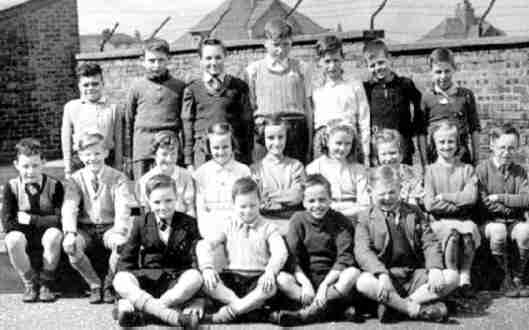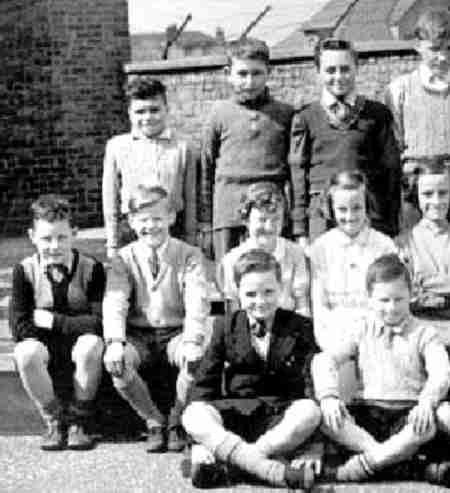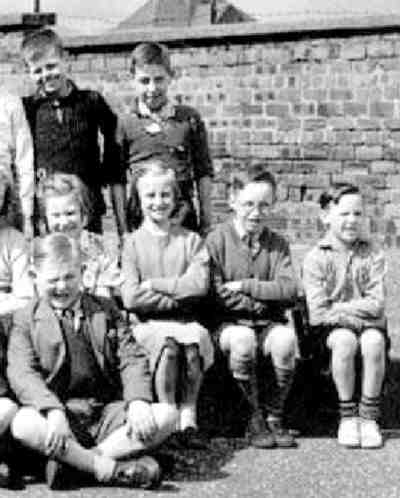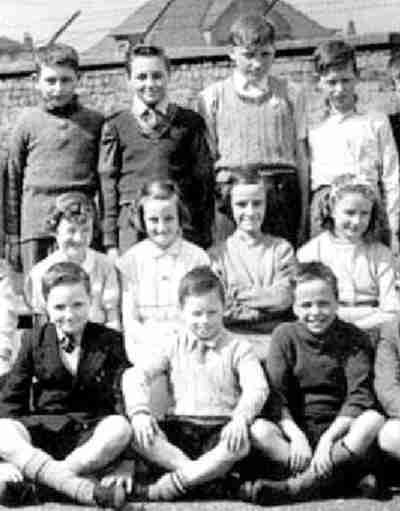
Figure 1.--This photograph shows how children at Craigieknowes Primary school dressed in 1954. This looks like one class at the school, probably the 10 year olds.


Figure 1.--This photograph shows how children at Craigieknowes Primary school dressed in 1954. This looks like one class at the school, probably the 10 year olds. |
Boys at Scottish primary schools mostly wore shortpants an
kneesocks uring the 1950s--at least uring the warmer summer months.
HBC is less sure about the winter. Boys at this school near Glasgow
did not wear kilts. But this may have been different in more traditional
areas of Scotland.
Craigeknowes is in Scotland. It is a few miles from Glasgow.
A Scottish primary school is a state school. It would be called an elementary or grae school in the Unite States. These schools were coeducational, working with both boys and girls.
A Scottish primary school is for chilren about 6-11 years. Children from this school would move on to seconary school at about age 11 years.

Figure 2.--The boys wither wear ties or have buttoned their collars. Notice the kneesocks the boy at the right wears with colored bands. |
Scottish state primary schools in the 1950s did not require uniforms, although many began adopting them in the 1960s. The boys at Craigieknowes in the 1950s woul have worn whatever their parents felt was suitable. There was no regulation about what the children should wear.
Boys at Craigieknowes wore a wide variety of clothes. Some boys wore suits and ties, other boys wore sweaters. All of the boys appear to be wearing short pants and kneesocks. Seceral boys appeear to be have let their socks fall down.
None of the boys wear caps in the photograph. Of course this is the school photograph, the boys would have taken their caps off when they got to school. It is not clear what the boys may have worn to and from school.
None of the boys wear blazers. This primary school school did not have a school blazer. Some of the boys wear suit jackets. As this was the school photograph day, some of the boys may have dressed up more than normally.
Most of the boys are wearing jackets or sweaters. The boys just wearing shirts are all wearing long sleeved shirts.

Figure 3.--Notice that the boy wearing sneakers at the right has kneesocks (whuch have fallen down) that have top bands in different colors than the boy n figure 2. |
Some of the boys wear ties. Even the boys who do not wear ties appear to have their collars buttoned.
Several of the boys are wearing sweaters. One boys wears a sleevless sweater.
All of the boys are wearing short pants, although it is no clear what the boys in the back row are wearing.
Although Craigieknowes is a Scottish school, there is no indication that any of the boys were wearing kilts. You might have thought that at least a few boys in the 1950s would have been wearing kilts. One HBC reader from Scotland reports, "I don't know anything about kilts as everyday wear but my impression is that they were not at all common. The only pictures of kilts I can rememberseeing are from private schools. I have a cousin who went to school in another town near Glasgow and as far as I know he didn't own a kilt - he was
very proud of his Scottish ancestry as a boy and I think he would probably have shown off his kilt if he had had one."
Most of the boys appear to be wearing kneesocks, although some have let them fall down. The kneesocks are quite varied. Some are plain grey while others have colored bands. Interestingly the boys do not wear kneesocks with the same colored top bands. Usually these socks have colore bands in the school colors, but this small primary school probably did not have such spealized kneesocks. It was thus not clear what school the socks are for. An English reaer explains, "Many of the chain stores did coloured tops to the socks....it did not signify a particular school....merely mums choice of top.....even in the 1970s Marks and Spencers sold either plain grey or black stripes..boys at primary wore either and even some cubs wore the striped ones." Another British contributor reports, "I remember that I sometimes wore socks with coloured tops before I had to wear a uniform. I assume that they were generally available." One boy in a suit appears to wear white anklesocks with a suit.

Figure 4.--Notice the variety of sweaters and shirts that the boys wear.. |
Most of the boys appear to be wearing lave up shoes. HBC does not note any sandals, but one boy does wear white plimsols (tennis shoes). Boys this age in Scotland woul have commonly worn school sandals. HBC is unsure why none of these boys wore them. Certainly it is a small sample. One British source comments, "There is no special reason that I know of to explain why none of the boys wore sanals. I could speculate that it may have been winter. {HBC believes in was about May or June.] Or perhaps it was just a day when no one chose to wear sandals.
This photograph was probably taken in May or June. All of the boys appear to be wearing shortpants. HBC is unsure what the boys would have worn in the winter. Many of the boys would have worn shorts in the winter as well--but probably not all of them.
State primary schools like this one di not commonly have clothing regulations and virtually none had uniforms in the 1950s. A British contributor reports, "I attended three primary schools up to 1954 and
there were no clothing regulations at any of them. It is probably worth bearing in mind the austerity of life in post-war
Britain. Clothing was rationed from 1942 until the early 1950s. I haven't been able to find the date for the end of clothes rationing but the last rationing restrictions were not lifted until 1953. It would probably have been impossible to enforce clothing regulations in schools while rationing was in force. Even after the end of rationing special clothes for primary school are likely to have been a low priority in a family's budget. Local council grants were available for school uniforms for families on low incomes when I went to the grammar school (they still are) and I can remember being given a copy of the regulations and an application form to take home to my parents, but I don't know if they received a grant or how many did."
Related Chronolgy Pages in the Boys' Historical Web Site
[The 1880s]
[The 1930s]
[The 1940s]
[The 1950s]
[The 1960s]
[The 1970s]
[The 1980s]
Related Style Pages in the Boys' Historical Web Site
[Long pants suits]
[Short pants suits]
[Socks]
[Eton suits]
[Jacket and trousers]
[Blazer]
[School sandals]
